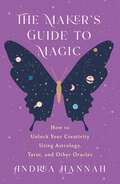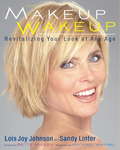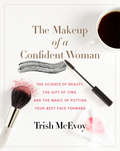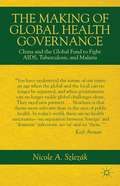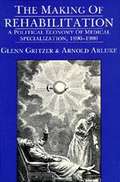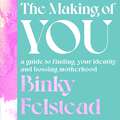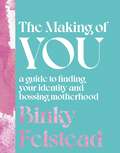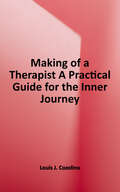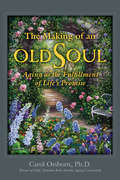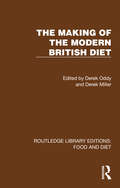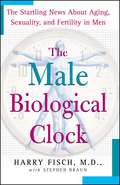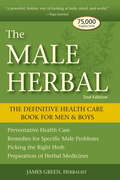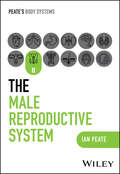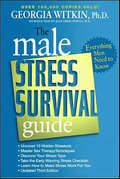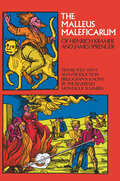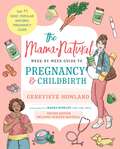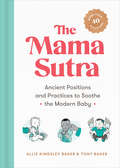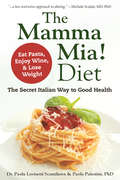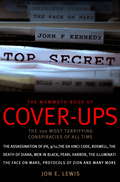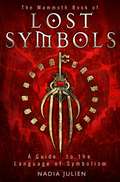- Table View
- List View
The Maker's Guide to Magic: How to Unlock Your Creativity Using Astrology, Tarot, and Other Oracles
by Andrea HannahA guide to unlock creativity through the use of tarot, astrology and other esoteric tools in the modern age.Every creative knows those magical moments of inspiration and flow can be hard to come by. And in today’s fast-paced, high-stress society, they can feel impossible to reach. Certified astrologer, yoga teacher and creativity workshop leader Andrea Hannah introduces an innovative approach that any maker can use to build their toolkit and align with their creative potential. Diving into astrology, tarot, the natural elements and other oracles, The Maker’s Guide to Magic breaks down these tools into manageable and easy-to-follow parts that anyone can use to access their creativity—whether they’re beginners in the esoteric realm or advanced practitioners. With the help of spreads, prompts, and other simple exercises, creatives will develop a fresh and customizable approach to explore their art in a mindful way.
The Makeup Wakeup: Revitalizing Your Look at Any Age
by Lois Joy Johnson Sandy LinterFace it--women fall into a beauty rut at a certain age, when their tried-and-true makeup techniques just aren't working anymore. That's when you know it's time for a Makeup Wakeup Beauty experts Lois Joy Johnson and Sandy Linter say it's time to learn what will work for women 40+ now. The Makeup Wakeup shares Lois and Sandy's inside information on what stars do; how to face demons like brow abuse and sun damage; even a fail-proof shopping guide. Though focused on the simplicity of makeup, the authors also consulted with three prominent doctors to address the concerns of women who opt for cosmetic procedures. Lois and Sandy say: Women 40+ tell us they feel invisible in a world of beauty that is really marketing to younger women. We felt a need to write a beauty guide we'd read ourselves, one that solved the kinds of issues women face every day.
The Makeup of a Confident Woman: The Science of Beauty, the Gift of Time, and the Power of Putting Your Best Face Forward
by Kristin Loberg Trish McevoyInternationally recognized makeup artist and trailblazing entrepreneur Trish McEvoy reveals her revolutionary, proven system that teaches women everywhere at any age to achieve total beauty security and confidence in this inspirational full-color playbook that is part empowering manifesto, part comprehensive how-to guide.Thousands of women, both celebrities and private clients alike, have turned to Trish McEvoy’s proprietary system for applying makeup, and looking—and feeling—transformed. Now, millions of women will have the opportunity to access her secret method in one complete, gorgeous book that goes beyond the basic step-by-step makeup lessons. Trish understands the power of beauty security. A woman with a positive self-image, can-do attitude, and sense of grace and calm will get what she wants out of life, and then some. But it’s not so easy to cultivate these qualities. Trish has a simple, 4-part solution. And it surprisingly starts with leveraging just a few minutes a day in a unique way. Even the most time-starved woman can do this, with lasting results.Compiling all of her best wisdom, Trish begins with a passionate and persuasive argument that makes clear the importance of self-care, then offers specific strategies to transform yourself from the outside in. Infused with Trish’s trademark charisma, this motivational, must-have resource is filled with highly practical takeaways and tutorials that will equip you with the tools to face life at your most beautiful and self-assured. The Makeup of a Confident Woman includes over 200 full-color illustrations.
The Making of Global Health Governance: China and the Global Fund to Fight AIDS, Tuberculosis, and Malaria
by Nicole A. SzlezákA study of governance in the emerging global domain, this book traces the evolution of global public policy making by focusing on four entities: a globalizing sector (health); a global disease (HIV/AIDS); a global organization (the Global Fund); and a major sovereign state (China).
The Making of Rehabilitation: A Political Economy of Medical Specialization, 1890-1980
by Glenn Gritzer Arnold ArlukeFocusing on the history of one medical field--rehabilitation medicine, this book provides the first systematic analysis of the underlying forces that shape medical specialization, challenging traditional explanations of occupational specialization.
The Making of You: A guide to finding your identity and bossing motherhood
by Binky FelsteadMagical highs and messy lows - motherhood is a rollercoaster of emotions, but it can be The Making of You.From the constant chatter of well-intentioned advice to the chaos of navigating how best to care for your little one, becoming a mother is exhausting.For Binky Felstead, Made in Chelsea star and co-founder of parenting advice app Bloss, becoming a mother marked the start of her journey towards feeling greater purpose and gratitude, but it wasn't an easy ride. Binky went from co-parenting and losing friendships, to struggling with miscarriage and navigating blended families causing her to feel full of the anxieties every new mother faces.In The Making of You, Binky - together with 30 experts - shares her experience along with the mindful tips and advice that helped grow her confidence and feel empowered to be the best version of herself for her and her children. Inside you'll find personal anecdotes with calming and practical advice on the first month with a newborn, body confidence, love and sex, managing money and work and finding that all important time for a little self-care.It's time to re-discover your identity and boss motherhood, so you can celebrate every step on this new adventure.
The Making of You: A guide to finding your identity and bossing motherhood
by Binky FelsteadMagical highs and messy lows - motherhood is a rollercoaster of emotions, but it can be The Making of You.From the constant chatter of well-intentioned advice to the chaos of navigating how best to care for your little one, becoming a mother is exhausting.For Binky Felstead, Made in Chelsea star and co-founder of parenting advice app Bloss, becoming a mother marked the start of her journey towards feeling greater purpose and gratitude, but it wasn't an easy ride. Binky went from co-parenting and losing friendships, to struggling with miscarriage and navigating blended families causing her to feel full of the anxieties every new mother faces.In The Making of You, Binky - together with 30 experts - shares her experience along with the mindful tips and advice that helped grow her confidence and feel empowered to be the best version of herself for her and her children. Inside you'll find personal anecdotes with calming and practical advice on the first month with a newborn, body confidence, love and sex, managing money and work and finding that all important time for a little self-care.It's time to re-discover your identity and boss motherhood, so you can celebrate every step on this new adventure.
The Making of You: A guide to finding your identity and bossing motherhood
by Binky FelsteadMagical highs and messy lows - motherhood is a rollercoaster of emotions, but it can be The Making of You.From the constant chatter of well-intentioned advice to the chaos of navigating how best to care for your little one, becoming a mother is exhausting.For Binky Felstead, Made in Chelsea star and co-founder of parenting advice app Bloss, becoming a mother marked the start of her journey towards feeling greater purpose and gratitude, but it wasn't an easy ride. Binky went from co-parenting and losing friendships, to struggling with miscarriage and navigating blended families causing her to feel full of the anxieties every new mother faces.In The Making of You, Binky - together with 30 experts - shares her experience along with the mindful tips and advice that helped grow her confidence and feel empowered to be the best version of herself for her and her children. Inside you'll find personal anecdotes with calming and practical advice on the first month with a newborn, body confidence, love and sex, managing money and work and finding that all important time for a little self-care.It's time to re-discover your identity and boss motherhood, so you can celebrate every step on this new adventure.
The Making of a Surgeon
by William A. NolenDr. Nolen takes us through the surgical residency and introduces us to the very real world where he was intern and chief resident for five years: New York's Bellevue State Hospital. Funny, compassionate, sometimes tragic, Nolen provides an intimate view of life in the wards, labs and operating rooms of a great hospital.
The Making of a Therapist: A Practical Guide for the Inner Journey
by Louis CozolinoTo help fellow psychotherapists stay sane by covering what wasn't taught in school, Cozolino (Pepperdine U., CA) offers advice based on his extensive clinical experience. Emphasizing the personal and emotional aspects of the profession rather than its theoretical orientations (though he does advise training in at least two), he presents survival strategies, principles, and suggested readings. Annotation ©2004 Book News, Inc., Portland, OR (booknews.com)
The Making of a Therapist: A Practical Guide for the Inner Journey
by Louis J. CozolinoA paperback edition of the classic guide for new therapists seeing clients for the first time. Veteran therapist and mental health writer Louis Cozolino’s classic text contains all of the things he wished someone had told him during the first weeks and months of his clinical training. Now available in paperback, the book includes guidance about working with your clients, such as how to cope with silence, handle their direct questions, and get them to talk less and say more. It also focuses on the inner experience of becoming a therapist and ways of thinking and feeling while sitting across from clients. It speaks honestly about not having all the answers, and shuttling up and down between your head and your heart, and mind and body, struggling clients sit before you. It balances the process of developing therapeutic skills while also taking an inner journey—to becoming the professional, and person, you hope to be. With a new introduction to the paperback edition, this book remains an essential clinical reference. A Test Bank is available for professors using the book as a course text.
The Making of an Old Soul: Aging as the Fulfillment of Life's Promise
by Carol OrsbornThe Making of an Old Soul: Aging as the Fulfillment of Life’s Promise is the healing vision of a woman who is a scholar in the fields of adult and spiritual development as well as a lifelong seeker. Based on a mystical experience that sheds light on the entire arc of life, Orsborn’s latest work revisions age not as diminishment but as the fulfillment of life’s promise. Bursting through the stereotypes into a world of old souls, Orsborn shows you how to embrace the luminous spirit within that beats steadily beyond the wounds of childhood, beyond the unintended consequences of your best-intentions, beyond the twists and turns of fate over which even at the peak of the developmental pyramid you have no control. This gem of a book affirms that hope is merited and that seekers of all ages and circumstances have what it takes to grow not just old, but old souls.
The Making of the Modern British Diet (Routledge Library Editions: Food and Diet)
by Derek Miller Derek OddyFood is the physiological basis of man’s existence but is also an expression of a society’s culture and may play many roles other than physiological in terms of both personal and group relationships. Originally published in 1976, The Making of the Modern British Diet focusses on the role of food during industrialisation and urbanisation in Britain.Part One contains a series of commodity studies covering bread, cereals, biscuits, meat, milk, tea and cocoa which reflect trends in the supply of some of the foods in the British diet during the nineteenth and early twentieth centuries. The emphasis in Part Two is predominantly on consumption, either through the study of living standards or consumer preference or through the presentation of food and the organisation of its outlets to the consumer. Part Three provides a nutritional evaluation which is an entirely new approach in an historical work.
The Male Biological Clock
by Harry Fisch Stephen BraunSay "biological clock" and most people think "women. " Yet men have biological clocks too, reveals Dr. Harry Fisch, one of the country's leading experts in male infertility and author of this groundbreaking new book, "The Male Biological Clock. " Men's clocks tick at a different rate from women's and of course cause an entirely different set of bodily and behavioral changes over the course of a lifetime. But while men's clocks don't strike a "midnight" toll heralding an end to fertility the way menopause does for women, male fertility, testosterone levels, and sexuality all do decline with age. Dr. Fisch's book emphasizes that even young men can have testosterone levels as low as those of much older men, leading to infertility, sexual problems, and other serious health issues. Another startling revelation is that men over thirty-five are twice as likely to be infertile as men younger than twenty-five. In addition, as men age, the quality of their sperm declines significantly, giving rise to an increased chance of a Down syndrome baby, other genetic abnormalities, and miscarriage. Every couple should know all the risks and issues facing men, because these affect two of the most important things in their life: their ability to have children and their capacity to have good sex. "The Male Biological Clock" is must reading for every man and every couple who is struggling to have children or improve their sex life. Many of Dr. Harry Fisch's findings are startling -- beginning with the fact that infertility is not mostly a women's problem -- and he offers many helpful suggestions for how to deal with declining testosterone, changing sexual needs, and the fertility industry. We have all heard stories of men becoming fathers in their seventies or even eighties, yet most of us are unaware that these are dangerously deceptive exceptions. Older men face a number of increased risks as fathers, and often find their sex lives and well-being changing considerably. The good news: Much can be done to slow down and even reverse the effects of a man's biological clock. "The Male Biological Clock" tells you what you need to know and how you can achieve optimal fertility and sexuality.
The Male Herbal: Health Care for Men and Boys (2nd edition)
by James GreenIn this long-awaited second edition of THE MALE HERBAL, James Green gives men and boys the tools they need to create or maintain physical and emotional health through a customized herbal program. By following Green's newly developed constitutional model and referencing the comprehensive alphabetical herbal listings, men can create an herbal program attuned to their unique body type, lifestyle, and health needs. Featuring life-changing information about common plants, herbal alternatives to Viagra, medicinal uses of herbs for male-specific issues, and nearly thirty recipes for teas, tinctures, salves, and tonics, this updated guide emphasizes prevention and health with sensitivity and wisdom.
The Male Reproductive System (Peate's Body Systems)
by Ian PeatePEATE’S BODY SYSTEMS THE MALE REPRODUCTIVE SYSTEM A CONCISE, ILLUSTRATED, AND ACCESSIBLE GUIDE TO THE MALE REPRODUCTIVE SYSTEM Each of the twelve volumes in Peate’s Body Systems series is rooted in the belief that a deep and thorough understanding of the human body is essential for providing the highest standard of care. Offering clear, accessible and up-to-date information on different body systems, this series bridges the gap between complex scientific concepts and practical, everyday applications in health and care settings. This series makes for an invaluable resource for those committed to understanding the intricacies of human biology, physiology and the various systems that sustain life. The Male Reproductive System is the perfect companion for students and newly registered practitioners across nursing and allied health fields with an interest in male reproductive health, providing a comprehensive yet easy-to-digest guide for both academic and clinical application. Equips healthcare students and practitioners with the necessary information to provide safe and competent careFeatures colourful illustrations to aid comprehension, clarify complicated concepts, and render content more engaging and accessible Empowers readers to adapt to a rapidly evolving healthcare landscape, preparing them for the future of healthcare delivery Contains information necessary for effective patient care of those with testicular torsion, Lower Urinary Tract Symptoms (LUTS), prostate cancer, and other male reproductive diseases and conditions
The Male Stress Survival Guide: Everything Men Need to Know
by Georgia WitkinIn this valuable, easy-to-read book, Dr. Witkin explains why men develop the stress symptoms they do; how stress affects their bodies, careers, families, personal goals and expectations; why they are particularly vulnerable to certain types of stress and not to others; and how to improve the quality and prolong the length of their lives. Her practical strategies include how to measure your stress level, uncover ten potent hidden stressors, utilize sex therapy techniques, learn how to make stress work for you, and tips for reducing Type A behavior.
The Malleus Maleficarum of Heinrich Kramer and James Sprenger (Dover Occult)
by Montague SummersFor nearly three centuries Malleus Maleficarum (The Witches' Hammer) was the professional manual for witch hunters. This work by two of the most famous Inquisitors of the age is still a document of the forces of that era's beliefs. Under a Bull of Pope Innocent VIII, Kramer and Sprenger exposed the heresy of those who did not believe in witches and set forth the proper order of the world with devils, witches, and the will of God. Even if you do not believe in witchcraft, the world of 1484 did.Contemporary cases illustrate methods by which witches attempt to control and subvert the world: How and why women roast their first-born male child; the confession of how to raise a tempest by a washwoman suspended "hardly clear of the ground" by her thumbs; methods of making a formal pact with the Devil; how witches deprive men of their vital member; and many others. Methods of destroying and curing witchcraft, such as remedies against incubus and succubus devils, are exemplified and weighed by the authors.Formal rules for initiating a process of justice are set down: how it should be conducted and the method of pronouncing sentence; when to use the trial by the red-hot-iron; how the prosecutor should protect himself; how the body is to be shaved and searched for tokens and amulets, including those sewn under the skin. As Summers says, it was the casebook on every magistrate's desk.Montague Summers has given a very sympathetic translation. His two introductions are filled with examples of witchcraft and the historical importance of Malleus Maleficarum. This famous document should interest the historian, the student of witchcraft and the occult, and the psychologist who is interested in the medieval mind as it was confronted with various forces which could be explained only by witchcraft.
The Mama Natural Week-by-Week Guide to Pregnancy and Childbirth
by Genevieve HowlandFrom Genevieve Howland, creator of the Mama Natural blog and YouTube channel, comes a &“must-read, comprehensive guide that empowers moms-to-be&” (Vani Hari, New York Times bestselling author) with week-by-week support to natural pregnancy.For the last half-century, doctors have controlled childbirth. Many pregnancy guidebooks are conventional, fear-based, and written by male physicians deeply entrenched in the old-school medical model of birth. But change is underway. Women are taking back their pregnancy and childbirth and embracing a natural way. Now, Genevieve Howland, the woman behind the enormously popular Mama Natural blog and YouTube channel, has created an inspiring, fun, and informative guide that demystifies natural pregnancy and walks moms through the process one week at a time. In this revised and updated edition, Howland includes the latest research and weekly advice and tips for a healthy pregnancy, detailing vital nutrition information, natural remedies for common and troublesome symptoms, as well as the appropriate (and inappropriate) use of interventions. Peppered throughout are positive birth and pregnancy stories from women of all backgrounds along with insights from experts including registered nurses, certified midwives, doulas, and lactation consultants. Encouraging, well-researched, and fun, The Mama Natural&’s Week-by-Week Guide to Pregnancy and Childbirth is an essential companion for women everywhere to embrace natural pregnancy and reap all the benefits for both baby and mama.
The Mama Sutra: Ancient Positions and Practices to Soothe the Modern Baby
by Tony Baker Allie Kingsley BakerA charming illustrated guide to burping, stimulating, and soothing your baby--so you can keep your sanity while helping your infant find inner peace.The Mama Sutra is an essential parenting handbook to more than forty methods to calm fussiness, encourage bowel movements, and (the holy grail) help everyone get back to sleep. Meet the Lucky Rabbit, the Drunk Monk, the Spraying Mantis, and other time-tested and scientifically proven ways to help your baby feel better, developed with help from experts in the ancient art of holistic healing. Whether your little one is experiencing reflux, colic, constipation, or something you can't quite identify, the simple and fun positions, holds, and massages in this adorable illustrated guide present solutions to soothe them, one beneficial pose at a time. You will become your baby's own enlightened guru.
The Mamma Mia! Diet: The Secret Italian Way to Good Health - Eat Pasta, Enjoy Wine, & Lose Weight
by Paola Lovisetti Scamihorn Paola PalestiniEat pasta, enjoy wine and lose weight! The Mamma Mia! Diet brings the health benefits of a Mediterranean-style program with Italian flair and flavor. It is authentic, effective, delicious and fun.The Mamma Mia! Diet is more than just a meal plan—it’s a complete lifestyle guide. Based on an improved version of the classic Mediterranean diet, the Mamma Mia! Diet provides you with modernized versions of healthy Italian dishes to help you lose weight while still feeling full and satisfied.The more doctors test it, the more they find that eating Mediterranean is the absolute best way to lose weight. Based on the cooking and eating style of Italy, the Mamma Mia! plan features olive oil, fruits and vegetables, nuts, legumes, fish and poultry, whole grains and, yes, wine! With The Mamma Mia! Diet, you’ll enjoy: • Better health and improved longevity • Higher energy levels and improved fitness • More variety than any other diet • Fundamental nutrition grounded in tradition and science • Incredible dishes packed with nutrition and authentic Italian flavor • A diet that nourishes you and your family, all in one Food can be more than just delicious. Food is medicine for the body, mind, and soul, and with The Mamma Mia! Diet, you can make the most out of what you eat, all while experiencing an Italian-style atmosphere—and satisfying an Italian-style appetite!The Mamma Mia! Diet is the modern Italian diet program that lets you enjoy the best of what Italian fare has to offer--absolutely guilt-free! Benefits of The Mamma Mia! Diet include weight loss, diabetes management, cardiovascular health and longevity.The Italian expression "Mamma mia!" denotes surprise such as "Mamma mia! I am eating good food, drinking wine, losing weight and feeling great!" The Mamma Mia! Diet shows that this is possible. • DOCTOR RECOMMENDED. Based on the time-tested Mediterranean diet, combined with a modern twist, The Mamma Mia! Diet gives you everything you need to make lasting lifestyle choices leading to better health, higher energy levels, and increased longevity. • ENJOY WHAT YOU EAT. Each meal is specifically crafted with three guiding principles in mind: achieving maximum nutritious value, maintaining the authentic taste of real Italian cuisine, and providing satisfying, filling portions that will leave you feeling energized all day long. • EASY-TO- FOLLOW. Every meal featured in The Mamma Mia! Diet can be made quickly and easily using commonly found foods, requiring no special skills. Based on the well-tested, tried and true Mediterranean diet, with Italian flavor and foods, The Mamma Mia! Diet is a healthy weight loss diet everyone can enjoy!
The Mammoth Book of Cover-Ups (Mammoth Books #371)
by Jon E. LewisThe Assassination of JFK, 9/11, the Da Vinci Code, The Death of Diana, Men in Black, Pearl Harbor, The Illuminati, Protocols of Zion,Hess, The Bilderberg Group, New World Order, ElvisFluoridization, Martin Luther King's murder, Opus Dei, The Gemstone Files, John Paul I, Dead Sea Scrolls, Lockerbie bombing, Black helicopters... In other words everything 'they' never wanted you to know and were afraid you might ask! Jon E. Lewis explores the 100 most terrifying cover-ups of all time, from the invention of Jesus' divinity (pace the Da Vinci Code) to Bush's and Blair's real agenda in invading Iraq. Entertainingly written and closely documented, the book provides each cover-up with a plausibility rating.Uncover why the Titanic sank, ponder the sinister Vatican/Mafia network that plotted the assassination of liberal John Paul, find out why NASA 'lost' its files on Mars, read why no-one enters Area 51, and consider why medical supplies were already on site at Edgware Road before the 7/7 bombs detonated. Just because you are paranoid, it doesn't mean that they aren't out to conspire against you.
The Mammoth Book of Lost Symbols: A Dictionary Of The Hidden Language Of Symbolism (Mammoth Books)
by Nadia JulienHumanity has always used symbols-material objects used to denote difficult, abstract concepts-to describe thoughts and feelings, or to protect secret truths from common knowledge. This concise A-Z guide is a fascinating work of reference that brings to light all the symbols and symbolisms of the world, many aspects of which have been lost to time, including Freemasonry, the Kabbalah, the tarot, astrology, alchemy, Zoroastrianism, and ancient cultures from Egypt to Japan.
The Mammoth Book of Lost Symbols: A Dictionary of the Hidden Language of Symbolism (Mammoth Books #343)
by Nadia JulienHumanity has always used symbols-material objects used to denote difficult, abstract concepts-to describe thoughts and feelings, or to protect secret truths from common knowledge. This concise A-Z guide is a fascinating work of reference that brings to light all the symbols and symbolisms of the world, many aspects of which have been lost to time, including Freemasonry, the Kabbalah, the tarot, astrology, alchemy, Zoroastrianism, and ancient cultures from Egypt to Japan.
The Mammoth Book of True Hauntings (Mammoth Books #270)
by Peter HainingThis giant collection includes a huge range of 20th-century first-hand accounts of hauntings, such as the American troops who repeatedly saw the ghosts of a dead platoon of men while on patrol in Vietnam; and the witnessed haunting of a house near Tintagel in Cornwall that led actress Kate Winslet to pull out of buying the property.It covers the full spectrum of credible hauntings, from poltergeists (the noisy, dangerous and frightening spirits that are usually associated with pubescent girls, like the Bell Witch), to phantoms (like the Afrits of Saudi Arabia) and seduction spirits (such as the Lorelei, which have lured German men to death).Also included are the notes of the most famous ghost hunters of the twentieth century such as Hans Holzer, Susy Smith (USA); Harry Price, Jenny Randles (UK); Joyce Zwarycz (Australia), Eric Rosenthal (South Africa), and Hwee Tan (Japan). Plus essays by such names as Robert Graves, Edgar Cayce, and M. R. James outlining their own - often extraordinary - conclusions as to just what ghosts might be; along with a full bibliography and list of useful resources.Praise for MBO Haunted House Stories:'A first rate list of contributors ... Hair raising!' Time Out'All we need say is buy it.' Starlog
